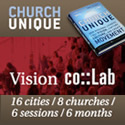Church Video Ideas: When the Screens Go Black
- Posted by: Todd
- Posted on: Wed, January 24, 2007
- Viewed 333
- (0) comments so far
The room was dim and there were candles all around, but the screens were blank and there was no media used the entire 36 hours. Was the room equipped? Absolutely – I play in a worship band every Tuesday night that meets in the same worship center and we use media each week. This was just a planned, intentional move to go without any media for the 36 hour event. I must say, I connected with God and worshipped like I haven’t in a long time.
Now please know this isn’t a new concept for me. I mention and throw out a challenge at each of my conferences for people to “not be afraid to let the screens go blank”. I say that everywhere I speak, but somehow this most recent experience really hit close to home for me. I found the lack of media to be quite freeing and refreshing. I must refer you to my opening paragraph again. I’m for media. I love it. I teach it. I believe God can use it in a powerful way. Let that be heard loud and clear. But let me also propose that we need to have a healthy perspective of how and why we use technology, that we understand that media is simply a communication tool and that it’s okay to not use it 100% of the time. Not only is this a wise view to have of using media in worship, but it can be quite powerful (as I experienced in the above mentioned worship experience).
This past Fall I did some seminars at Prestonwood Baptist Church. One of the seminars that I did for their teaching team was one I do at pastors’ conferences entitled “Communicating to those that Listen with Their Eyes”. The night before the seminar it dawned on me that Jack Graham was heard worldwide via the radio and podcasts. I realized that a lot of what I was planning to say on how to communicate utilizing visuals wouldn’t apply to messages heard over the radio. God laid it on my heart to add a whole new section on painting a picture with your words and tapping into the power of the imagination. I told them my regular comment on not being afraid of having your screens go to black. I encouraged them to let their screens go black and then say something like, “Close your eyes and listen as I read this story.” or “Close your eyes and listen as I read this passage of Scripture.” I think most communicators underestimate the power of the imagination. To improve your effectiveness as a communicator, practice painting a picture with your words.
Here are some quotes that I share in my communication/preaching seminars:
•“We can apply this understanding to our own creative efforts at many levels. On the most superficial level, we learn from the prophets that the tools best suited for communicating to the imagination are image, parables and sometimes even bizarre activity! At a deeper level, we learn that if we are to affect permanent change in people’s hearts, we must do more than simply teach them facts or reduce them to some emotional experience. Like the prophets, we must learn to reach out to the heart as well as the mind by speaking to the imagination. We must allow our audience the freedom to make realizations on their own, as with the parables of the prophets, particularly the prophet Jesus!”– Michael Card, Scribbling in the Sand
•“Creativity is part of God’s divine nature, and He has given it to us as a gift. Like so many of God’s gifts, creativity is often neglected or wrongfully used…Imagination is the first storytelling tool. To properly tell a story, you must see it in your mind.” – John Walsh, author of The Art of Storytelling
•“Our imaginations are involved in every area of our lives, in everything we do or say or are. It is no wonder that God is so intent upon recapturing them. Therefore, we must seek to understand the imagination biblically, that is, Christ-centeredly. The imagination is the bridge between the heart and the mind, integrating both, allowing us to think/understand with our hearts and feel/emote with our minds. It is a vehicle for truth. Through the use of images, metaphors, stories and paradoxes that demand our attention, it calls for our interaction. The imagination is a powerful means for communicating truths about God, and so God shows an awesome regard for the imagination in His Word. Because we are called to creativity, a working, gut-level understanding of the imagination is vital. It can be our greatest strength or our greatest weakness. To harness the imagination, or better yet, to bring it under submission to Christ is something about which we don’t talk or pray or do enough. – Michael Card, Scribbling in the Sand
•“Frequently, creativity and imaginativeness are casualties of ministerial education. Ministers start to mistrust or ignore their own creative impulses; they come to view imagination as a child’s play toy rather than an essential tool for vibrant communication.” – David Enyart
Let me end this article by simply stating that I believe technology and the use of it in worship is a God-thing and is being used to change lives. Let me also offer the counsel to seek to gain a healthy understanding of technology, its role, its potential and its power when used properly, purposefully and intentionally. Let me also end with a challenge to find those special times to allow the screens to go blank and let people use their God-given imaginations; it just might lead to some of your most meaningful and memorable moments in worship.
TAGS: Church Technology
©2007 – Greg Atkinson (www.churchvideoideas.com)
Used by permission from author. All rights reserved by author.
 Greg Atkinson lives in Dallas with his wife and their three small children. Greg served previously as the Director of WorshipHouse Media, after having served as a worship pastor for 11 years. He is the Founder of Multisensoryworship.com and Co-Founder of Wasteland Creative, where he continues to consult, teach and write about worship, media and creative communication. You can connect with him through his daily blog, Church Video Ideas, his podcast, Creative Synergy, or his email: .
Greg Atkinson lives in Dallas with his wife and their three small children. Greg served previously as the Director of WorshipHouse Media, after having served as a worship pastor for 11 years. He is the Founder of Multisensoryworship.com and Co-Founder of Wasteland Creative, where he continues to consult, teach and write about worship, media and creative communication. You can connect with him through his daily blog, Church Video Ideas, his podcast, Creative Synergy, or his email: .
Quick background info: I love the arts, specifically the use of media in worship. I wouldn’t call myself a “techie”, but I believe God uses technology and am very passionate about churches utilizing technology to communicate the Gospel. I’ve spent several years speaking, writing and consulting on the subject. With all that being said, I want to talk about when the screens go black on purpose. Recently, I was a part of a 36 hour worship experience here in Dallas called “Burn Dallas”. 18 worship leaders from Dallas took 2 hour shifts and led worship and prayer continually in the same place for 36 hours straight. It was an amazing experience that is happening in cities throughout the country. I came for the worship leader before me, then led worship for 2 hours, then stayed for the worship leader after me. I had an amazing time encountering God and being in His presence. It really was a powerful time; however I couldn’t help but notice that no media was used...
Comments
if you want a Globally Recognized Avatar (the images next to your profile) get them here. Once you sign up, they will displayed on any website that supports them.






Post a Comment